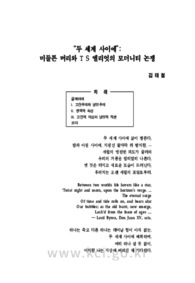

PARTNER
검증된 파트너 제휴사 자료
“두 세계 사이에”: 미들튼 머리와 T S 엘리엇의 모더니티 논쟁 (“Between Two Worlds”: J Middleton Murry and T S Eliot on Modernity)
37 페이지
최초등록일 2025.04.14
최종저작일
2010.06

-
미리보기
서지정보
· 발행기관 : 한국외국어대학교 영미연구소
· 수록지 정보 : 영미연구 / 22권 / 3 ~ 39페이지
· 저자명 : 김태철
초록
This essay reads as the critical discourse of modernity the interactions between John Middleton Murry and T S Eliot in the literary journals of the Adelphi and the Criterion in the 1920s, through which approach their debate proves to be no other than diametrically different versions of modernity recognition, and then modernity project, between two worlds. Their controversies can be sorted out into two groups by topics and roughly in time sequence: in the first round of the debate, they form their own different conceptions of classicism and romanticism with the help of the other’s arguments, which serves as the frames of reference for the next one; now in the second, exploring the human soul under modernity, they seek for the possibility of a synthesis between romantic intuition and classical intelligence. Over this debate, the British empiricist Murry identifies romanticism with modernity itself dating back to the Renaissance, and then presents as his project of modernity a fuller realisation of romanticism of his own idiosyncratic understanding. Which is to say a new synthesis of intuition and intelligence into enlightened reason in allusion to the mediaeval Thomist synthesis of reason and faith. On the other hand, the Euro-centric rationalist Eliot expects much of classical intelligence for romanticism to be overcome, and for classical ideals to be restored or, more precisely, for the unified sensibility to be regained and for the integrated intelligence to be revived, which means he is in resolute and unshakable pursuit of a project of modernity. In the course of their eight-year-long interactions, it transpires, Murry elaborates on the recognition of modernity rather than on its project, and Eliot does the other way round. In other words, both of them fail to represent their contemporary stage of ever-deepening modernity fully enough in their discourse of modernity. Theirs remain as unfinished projects of modernity.영어초록
This essay reads as the critical discourse of modernity the interactions between John Middleton Murry and T S Eliot in the literary journals of the Adelphi and the Criterion in the 1920s, through which approach their debate proves to be no other than diametrically different versions of modernity recognition, and then modernity project, between two worlds. Their controversies can be sorted out into two groups by topics and roughly in time sequence: in the first round of the debate, they form their own different conceptions of classicism and romanticism with the help of the other’s arguments, which serves as the frames of reference for the next one; now in the second, exploring the human soul under modernity, they seek for the possibility of a synthesis between romantic intuition and classical intelligence. Over this debate, the British empiricist Murry identifies romanticism with modernity itself dating back to the Renaissance, and then presents as his project of modernity a fuller realisation of romanticism of his own idiosyncratic understanding. Which is to say a new synthesis of intuition and intelligence into enlightened reason in allusion to the mediaeval Thomist synthesis of reason and faith. On the other hand, the Euro-centric rationalist Eliot expects much of classical intelligence for romanticism to be overcome, and for classical ideals to be restored or, more precisely, for the unified sensibility to be regained and for the integrated intelligence to be revived, which means he is in resolute and unshakable pursuit of a project of modernity. In the course of their eight-year-long interactions, it transpires, Murry elaborates on the recognition of modernity rather than on its project, and Eliot does the other way round. In other words, both of them fail to represent their contemporary stage of ever-deepening modernity fully enough in their discourse of modernity. Theirs remain as unfinished projects of modernity.참고자료
· 없음태그
-
자주묻는질문의 답변을 확인해 주세요

꼭 알아주세요
-
자료의 정보 및 내용의 진실성에 대하여 해피캠퍼스는 보증하지 않으며, 해당 정보 및 게시물 저작권과 기타 법적 책임은 자료 등록자에게 있습니다.
자료 및 게시물 내용의 불법적 이용, 무단 전재∙배포는 금지되어 있습니다.
저작권침해, 명예훼손 등 분쟁 요소 발견 시 고객센터의 저작권침해 신고센터를 이용해 주시기 바랍니다. -
해피캠퍼스는 구매자와 판매자 모두가 만족하는 서비스가 되도록 노력하고 있으며, 아래의 4가지 자료환불 조건을 꼭 확인해주시기 바랍니다.
파일오류 중복자료 저작권 없음 설명과 실제 내용 불일치 파일의 다운로드가 제대로 되지 않거나 파일형식에 맞는 프로그램으로 정상 작동하지 않는 경우 다른 자료와 70% 이상 내용이 일치하는 경우 (중복임을 확인할 수 있는 근거 필요함) 인터넷의 다른 사이트, 연구기관, 학교, 서적 등의 자료를 도용한 경우 자료의 설명과 실제 자료의 내용이 일치하지 않는 경우
“영미연구”의 다른 논문도 확인해 보세요!
-
현대 생성통사론 연구의 전망과 방향 34 페이지
This paper is purposed to investigate what modern syntax is doing and to prospect which direction it is headed for. As a pursuit of minimalism, generative syntax has been one of the most heated field .. -
A Contrastive Study of Compliment Responses of Korean, Chinese and Eng.. 32 페이지
In this study, the compliment response behavior of native Korean speakers and Mandarin Chinese speakers, who are basically regarded as having rules of speaking and social norms very different from tho..
문서 초안을 생성해주는 EasyAI
